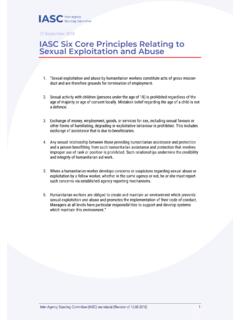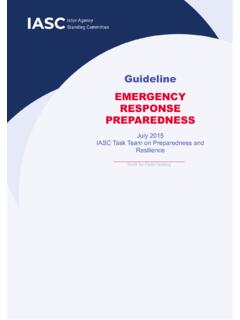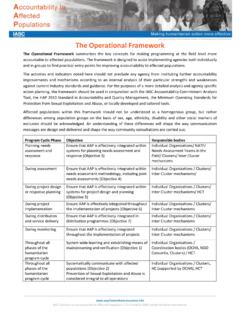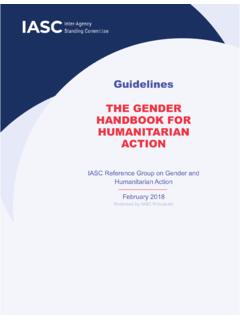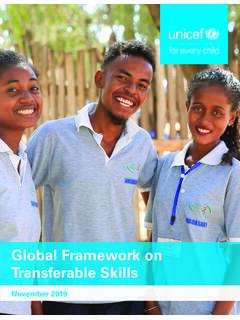Transcription of Mapping Good Practice in the Implementation of ...
1 SYNTHESIS REPORTThis report provides a summary of the initiative Mapping good Practice in the Implementation of humanitarian-development-peace (HDP) nexus approaches carried out by IASC Results Group 4. It reflects findings across 16 countries, with individual country reports available on the IASC website. inter - agency standing Committee (IASC) Results Group 4 September 2021 Mapping Good Practice in the Implementation of Humanitarian-Development-Peace Neus ApproachesSynthesis Report2 Mapping Good Practice in the Implementation of Humanitarian-Development-Peace Nexus ApproachesINTRODUCTION To reduce need, risk and vulnerability, increasing numbers of countries are implementing the nexus approach. This has led to a growing and diverse experience in its operationalization, lessons learned and good Practice . In response to demand by IASC members, Member States and donors for operational examples, good Practice and lessons learned, Results Group 4 embarked on a Mapping exercise in 2021.
2 The aim was to provide a global overview of where and how HDP nexus approaches are implemented, and gather good Practice and lessons learned. The Mapping is based on the nexus definition adopted in the IASC Light Guidance on Collec-tive Outcomes. The guidance describes the HDP nexus as a collective effort by humanitarian, development and, where relevant and appropriate, peace actors to reduce people s humanitarian needs, risks and vulnerabilities by working towards collective outcomes or HDP priority areas as follows: Joint analysis or sharing of analyses to obtain a shared understanding of need, risk and vulnerability. Articulation of collective outcomes or HDP priority areas based on the areas of greatest need, risk and vulnerability. Joined-up planning and program-ming in support of these collective outcomes or priorities. Financing that is aligned or harmonized around these collective outcomes or Mapping follows these operational steps as the key components that have been defined to constitute the HDP nexus.
3 While the Mapping captures the progress made in implementing collective outcomes, it is not exclusive of other approaches that have been developed and imple-mented at the country Mapping also covers the thematic areas of peace, gender and local actors. These themes were selected as they are intrinsically linked to the HDP nexus and require attention in its imple-mentation. The Mapping was conducted by a subgroup of Results Group 4, convened by OCHA in collabo-ration with DCO, FAO, ICVA, IOM, Oxfam, PBSO, UNDP, UNFPA, WFP, WVI and the Global Protection Cluster. The subgroup developed the concept and agreed on a set of survey questions and countries. The Mapping covers Afghanistan, Burkina Faso, Burundi, Cameroon, Central African Republic (CAR), Colombia, Democratic Republic of the Congo (DRC), Haiti, Iraq, Jordan, Lebanon, Libya, occupied Palestinian territory (oPt), Somalia, Sudan and Ukraine.
4 Resident Coordinators/Humanitarian Coordina-tors (RC/HCs) in these countries were asked to consult with key stakeholders and describe the overall HDP nexus approach; collective outcomes or other HDP priority areas; and how they engaged in joined-up planning, programming and financing around these priorities. They were also asked how peace, gender and local actors featured in the HDP nexus approach. The below sections summarize the key findings based on analysis across the 16 individual country reports, outlining areas where progress has been made, as well as challenges and gaps that require further support. WHAT S INSIDE Operationalizing the Nexus 3 Spotlight on Peace, Gender and Local Actors 6 Areas for Further IASC Support 103 Mapping Good Practice in the Implementation of Humanitarian-Development-Peace Nexus ApproachesOPERATIONALIZING THE NEXUSD espite global guidance on the HDP nexus, more needs to be done to create a common under- standing of the nexus at the country level.
5 The global community has invested in developing nexus guidance based on lessons learned as well as providing training and support to RC/HCs, UNCTs and HCTs, including through joint support missions (the IASC, the JSC and the OECD-DAC). Progress in implementing nexus approaches at the country level is evident, but several countries reported challenges in creating a unified understanding of the nexus approach among stakeholders, with diverging views and interpretations. More work is required to famil-iarize stakeholders with guidance documents, in combination with continued, unified support and incentives from headquarters and donors for collective approaches. Strong multi-stakeholder engagement is needed to support progress across the HDP nexus. Country-level efforts to implement nexus approaches are becoming increasingly collective. In many countries, nexus working groups and task forces include national and local authorities; UN entities; national and international NGOs; the World Bank; and bilateral donors.
6 Good Practice in working with national and local authorities and civil society range from a High-Level Triple Nexus Steering Committee endorsed by the Prime Minister in Somalia, to the participation of national NGOs in the HCT in Haiti and the establishment of local-level coordination mechanisms in Colombia. Bilateral donors are increasingly engaged through nexus working groups and task forces. In some countries, such as Burkina Faso, DRC and Haiti, individual donors have played a lead role or championed the nexus advances were made in leadership, sharing of analysis, common priority setting (collective outcomes) and joined-up planning. RC/HCs have taken up a leadership role in initiating, coordinating and facilitating nexus approaches. Country teams have strengthened the sharing of analysis and engaged in more joined-up planning on HDP priorities in all countries.
7 Many countries used the new Common Country Analysis (CCA) and United Nations Sustainable Development Cooperation Framework (UNSDCF) processes as an opportunity to define common HDP priorities, while drawing on the analysis of the Humanitarian Needs Overviews and ensuring complementarity with Humanitarian Response Plans (HRPs). Collective outcomes are increasingly used to support progress on reducing needs, risks and vulnerability. In 10 of the 16 countries, collective outcomes were either already used or planned for the upcoming planning cycle to strategically guide interventions through collaboration between humanitarian, development and peace actors. In Somalia, the strategic objectives set out in the HRP are aligned with those of the UNSDCF and both plans reflect the agreed collective outcomes. Already done in 2021 CountryProcess starts in 2022 AfghanistanBurkina FasoBurundiCameroonCentral African RepublicChadColombiaDR of the CongoHaitiIraqJordanLebanonLibyaoccupied Palestinian territorySomaliaSudanUkraineTimeline for UNSDCF processes by country4 Mapping Good Practice in the Implementation of Humanitarian-Development-Peace Nexus ApproachesIn Haiti and Ukraine, where collective outcomes have not yet been identified, the HRP contains a specific strategic objective on humanitarian-de-velopment collaboration.
8 Collective outcomes are not a prerequisite for an HDP nexus approach, and the Mapping highlights other effective nexus approaches, such as in CAR, where dedicated working groups are ensuring progress on HDP priorities at the subnational is still a need for strengthened alignment of programmes and projects towards HDP prior-ities or collective outcomes. The Mapping shows that challenges remain in moving from nation-al-level coordination and planning around the nexus to designing programme-level activities at the subnational level. Ensuring complementarity of humanitarian, development and peacebuilding programmes towards common priorities does not require joint programming or financing. In Cameroon, the early identification of convergence zones or geographic focus areas has helped ensure strengthened programming towards collective outcomes, thus increasing the impact on communities.
9 In DRC, mainstreaming collec-tive outcomes into provincial development plans, combined with multi-stakeholder workshops in the most vulnerable provinces, aims to bridge the gap between national-level planning and programme Implementation . In Ukraine, the HDP nexus approach is driven at the local level by the UN, NGOs and local authorities through project activities supported by national-level strategic consultations. There is also a need for more targeted funding and financing of programmes and projects that contribute to HDP priorities (rather than based on the interests and priorities of individual donors). In Burkina Faso, donors have been involved in identifying HDP priorities, and they are increasingly financing initiatives in line with these priorities in areas such as WASH, food assistance, social protection and peacebuilding. While several countries reported a lack of compat-ibility of existing financing instruments, others have developed dedicated funds (Cameroon) or financing agreements (Jordan) to support programming across the HDP nexus.
10 The Ukraine Humanitarian Fund 2020 standard allocation to Government-controlled areas required all project proposals to contain a nexus component. Finally, some countries, such as Afghanistan and CAR, have made social protection a major focus of the nexus countries have highlighted an urgent need for dedicated nexus adviser capacity to coordi-nate the HDP nexus approach around analysis, planning and programming across the HDP nexus. Most countries have highlighted that the Resident Coordinator s Office (RCO) could benefit from dedicated nexus adviser capacity. Countries highlighted the need for a person who supports the RC in (i) convening, facilitating and coordi-nating the nexus approach around analysis; (ii) setting HDP priorities; (iii) supporting joined-up planning and programming with partners; and (iv) ensuring inclusion of Government, donors, NGOs and local actors in HDP priority setting and planning.
